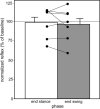Influence of combined action observation and motor imagery of walking on lower limb reflex modulation in patients after stroke-preliminary results
- PMID: 35562777
- PMCID: PMC9101860
- DOI: 10.1186/s13104-022-06057-5
Influence of combined action observation and motor imagery of walking on lower limb reflex modulation in patients after stroke-preliminary results
Abstract
Objective: The combined use of action observation and motor imagery (AOMI) is a promising technique in neurorehabilitation that can be usefully applied in addition to conventional forms of therapy. Previous studies with healthy participants showed that the mere passive observation of walking results in a phase-dependent reflex modulation in the tibialis anterior muscle that resembles the pattern occurring when walking. In patients after stroke, a similar reflex modulation was found in several lower limb muscles during the real execution of walking, but responses were blunted. To clarify whether and how lower limb reflex responses are also modulated in such patients during the combined synchronous observation and imagery of walking, medium-latency cutaneous reflexes from the tibialis anterior muscle were measured. We compared the reflex responses of seven patients after stroke during the AOMI of walking from two different conditions: (a) elicited during the end stance phase and (b) during the end swing phase, both normalized to a baseline condition.
Results: So far, using the identical methodological set-up as in our study with healthy individuals, we could not find any noteworthy reflex response modulation. The study was registered with the German Clinical Trials Register (DRKS00028255).
Trial registration: The study was registered with the German Clinical Trials Register: DRKS00028255.
Keywords: Action observation; Motor imagery; Reflex responses; Stroke; Walking.
© 2022. The Author(s).
Conflict of interest statement
The authors declare that they have no competing interests.
Figures
Similar articles
-
Phase-dependent reflex modulation in tibialis anterior during passive viewing of walking.Acta Psychol (Amst). 2013 Mar;142(3):343-8. doi: 10.1016/j.actpsy.2013.01.001. Epub 2013 Feb 16. Acta Psychol (Amst). 2013. PMID: 23422287
-
Load-related modulation of cutaneous reflexes in the tibialis anterior muscle during passive walking in humans.Eur J Neurosci. 2008 Mar;27(6):1566-76. doi: 10.1111/j.1460-9568.2008.06120.x. Eur J Neurosci. 2008. PMID: 18364029
-
Contributions to the understanding of gait control.Dan Med J. 2014 Apr;61(4):B4823. Dan Med J. 2014. PMID: 24814597 Review.
-
Modulation of Hoffmann reflex excitability during action observation of walking with and without motor imagery.Neurosci Lett. 2018 Sep 25;684:218-222. doi: 10.1016/j.neulet.2018.07.041. Epub 2018 Jul 31. Neurosci Lett. 2018. PMID: 30075283
-
What functions do reflexes serve during human locomotion?Prog Neurobiol. 1999 Jun;58(2):185-205. doi: 10.1016/s0301-0082(98)00081-1. Prog Neurobiol. 1999. PMID: 10338359 Review.
References
-
- Buccino G, Solodkin A, Small SL. Functions of the mirror neuron system: implications for neurorehabilitation. Cognit Behav Neurol. 2006;19(1):55–63. - PubMed
MeSH terms
LinkOut - more resources
Full Text Sources
Medical


